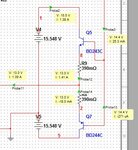rahdirs
Advanced Member level 1

Hi all,
I need to design a power amplifier that provides a current gain from 25 mA to 10 A keeping the voltage constant.
The input to the power amplifier is an almost constant DC voltage between 11 & 12 V and at 15-25 mA. I need an output at same voltage and 10 A.There will be no cases of cross-over distortion in my circuit,so i think even class B would work properly
I tried and got only an amplification of 60 as in schematic.
We can't change the impedance of stage next to amplifier

I need to design a power amplifier that provides a current gain from 25 mA to 10 A keeping the voltage constant.
The input to the power amplifier is an almost constant DC voltage between 11 & 12 V and at 15-25 mA. I need an output at same voltage and 10 A.There will be no cases of cross-over distortion in my circuit,so i think even class B would work properly
I tried and got only an amplification of 60 as in schematic.
We can't change the impedance of stage next to amplifier

Last edited:











